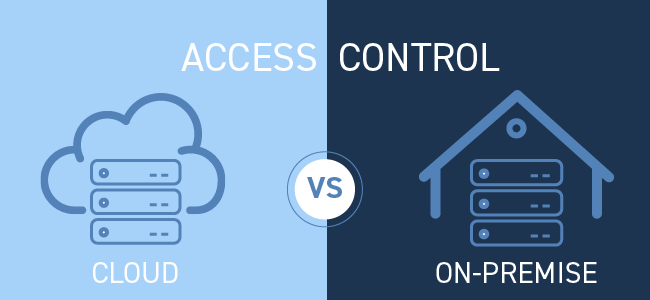Access Control in the UK: Cloud vs On-Premise Explained Clearly
Choosing between cloud and on-premise access control is one of the most consequential security decision for UK organizations. This guide from XS Controls compares functionality, cost, compliance, reliability and long-term value so facilities managers and IT teams can make a confident choice.
What we mean by cloud vs on premise access control
When people discuss cloud vs on premise access control they are comparing where the access control software and data are hosted — either in a vendor’s cloud or on servers you own and manage. Cloud systems deliver web and app-based management from anywhere; on-premise systems run locally and typically require dedicated hardware and IT support.
Benefits of cloud-based solutions

Cloud-based access control solutions simplify multi-site management, push automatic updates, and reduce the need for on-site servers and specialist IT staff. Cloud platforms make rollouts and permission changes faster across distributed offices — a major plus for organizations with hybrid working patterns.
Why some organisations still choose on-premise
On-premise systems remain attractive where absolute data control, offline operation, or bespoke integrations are critical. Organisations with strict regulatory or internal data governance rules often prefer on-premise to minimise third-party exposure and to host sensitive logs inside their network. entrust-ed.co.uk
Security: cloud vs on premise access control
Security is often the deciding factor. Cloud vendors invest heavily in encryption, monitoring, and redundancy at scale, and for many UK businesses, the cloud offers stronger, centrally maintained defense than small in-house teams can deliver. However, if you need full control of keys and logs for compliance or specific audit trails, on-premise still wins.
Cost and total cost of ownership
Upfront costs for on-premise systems are typically higher — servers, licences, installation and ongoing maintenance. Cloud models shift costs to predictable subscriptions and reduce capital expenditure, though long-term subscription fees can add up. Consider total cost of ownership (TCO) over five years, including staff time, replacements and upgrade cycles.
Performance and reliability
Cloud systems depend on internet connectivity; plan for failover and local caching if uptime is critical. On-premise systems can function independently of web connectivity but need local redundancy to guard against power or hardware failure. Hybrid designs can combine cached local control with cloud-based central management.
Compliance and data residency

UK organizations must consider GDPR and local data residency. Many reputable cloud providers host data in EU/UK regions and publish compliance documentation — but due diligence is essential. If your organization handles particularly sensitive personal data, check the provider’s data processing terms and support for Subject Access Requests. XS Controls+1
Integration and future-proofing
Cloud access control solutions often provide open APIs and easier integrations with video, building management and HR systems. On-premise solutions can be tightly customized but may require bespoke development to connect modern cloud-native services. For future-proofing, prioritize platforms with clear roadmaps, UK references and strong SLAs.
Migration and rollout: practical steps for UK sites
When planning a move from legacy systems to cloud, follow a phased approach. Start with a pilot building, document network requirements, and train local security teams. Budget for card credential re-issuance, staff time, and a short hypercare period with the vendor. During the pilot, compare response times and offline behaviour between cloud vs on premise access control to validate your design.
Vendor selection criteria
Select vendors by evaluating encryption standards, data residency options, uptime SLAs, patching cadence and UK support. Request penetration test reports and customer references in the UK. Ask vendors to explain how their cloud architecture handles emergency lock-downs and how it compares to typical on-premise lock-down procedures. Include a proof-of-concept phase and insist on a written SLA for response times.
Operational impacts and change management
Moving to cloud-based solutions changes workflows: remote support replaces on-site trips, firmware updates are simpler, and administrators use web consoles and apps more. Discuss these operational changes with your security team and stakeholders so the transition is smooth. Compare operational overhead between cloud vs on premise access control to set realistic expectations.
Cost modelling example
Build a five-year cost model that includes capital expenditure for controllers, readers and servers (on-premise) versus subscription fees, network upgrades and mobile credentialing (cloud). Remember hidden costs: patch management, staff training, and migration labour can materially change TCO. Use scenario analysis — best case, expected, and worst case — to compare cloud vs on premise access control financially.
FAQs
Is cloud less secure than on-premise? Cloud providers often offer enterprise-grade security and redundancy; security depends on vendor controls and contracts.
Can I mix cloud and on-premise? Yes — hybrid models are common and practical.
What about data breaches? Ensure vendor incident response plans, breach notification windows and UK-based legal counsel support.
Real-world use cases
Choose cloud when you need scalable multi-site management, rapid provisioning for contractors, remote unlocking, and simple mobile credentialing. Cloud is especially compelling for SMEs, growing chains, universities and flexible office operators. Choose on-premise for critical national infrastructure, environments with intermittent internet, or where internal policy demands complete local control over security systems and data.
Final recommendation
The debate between cloud and on-premise is often framed as: cloud vs on premise access control. The right choice depends on your risk appetite, IT capability and regulatory needs. For most modern UK organisations seeking agility, lower upfront costs and simplified management, cloud based access control solutions are the default recommendation. For mission-critical sites and those with strict data control needs, on-premise or hybrid models remain viable. Whichever path you choose, evaluate actual deployments in UK conditions and insist on a tailored SLA.

